Box Hill: Difference between revisions
Created page with '{{distinguish|Box Hill, Wiltshire}} {{Infobox hill |name=Box Hill |picture=Box Hill - geograph.org.uk - 382696.jpg |picture caption=Box Hill |height=735 feet |range=North Downs |…' |
No edit summary |
||
| (One intermediate revision by one other user not shown) | |||
| Line 7: | Line 7: | ||
|range=North Downs | |range=North Downs | ||
|county=Surrey | |county=Surrey | ||
|latitude=51.246897 | |||
|longitude=-0.312185 | |||
|os grid ref =TQ179511 | |os grid ref =TQ179511 | ||
}} | }} | ||
| Line 29: | Line 31: | ||
==Box Hill village== | ==Box Hill village== | ||
[[File:The entrance to Hillcrest at Box Hill village - geograph.org.uk - 54147.jpg|thumb|250px|Box Hill village]] | |||
The village of Box Hill is located to the east of the National Trust property. The earliest flint cottages date from the 1800s, although much of the village was constructed in the first half of the 20th century.<ref>{{harvnb|Mountford|1974|pp=3–4}}</ref> By 2005 there were more than 800 dwellings of which over five hundred were mobile homes. An estimated 41% of the community is aged 60 or over.<ref>{{cite web |url=http://www.connectedsurrey.com/stylesheet.asp?file=17032006112104 |title=Box Hill Project |author=Fry R |year=2006 |work=Community Case Studies |publisher=The Connected Surrey Partnership |accessdate=13 April 2011}}</ref> St Andrew's Church, part of the Parish of Headley, was opened in 1969 and the village hall opened in 1972.<ref>{{cite web |url=http://myweb.tiscali.co.uk/friendsofstandrewsbh/history_part_1.htm |title=History |author=Langley D |year=2000 |work=The Church on the Hill |publisher=Friends of St Andrews Box Hill |accessdate=3 April 2011}}</ref><ref>{{harvnb|Mountford|1974|p=3}}</ref> | The village of Box Hill is located to the east of the National Trust property. The earliest flint cottages date from the 1800s, although much of the village was constructed in the first half of the 20th century.<ref>{{harvnb|Mountford|1974|pp=3–4}}</ref> By 2005 there were more than 800 dwellings of which over five hundred were mobile homes. An estimated 41% of the community is aged 60 or over.<ref>{{cite web |url=http://www.connectedsurrey.com/stylesheet.asp?file=17032006112104 |title=Box Hill Project |author=Fry R |year=2006 |work=Community Case Studies |publisher=The Connected Surrey Partnership |accessdate=13 April 2011}}</ref> St Andrew's Church, part of the Parish of Headley, was opened in 1969 and the village hall opened in 1972.<ref>{{cite web |url=http://myweb.tiscali.co.uk/friendsofstandrewsbh/history_part_1.htm |title=History |author=Langley D |year=2000 |work=The Church on the Hill |publisher=Friends of St Andrews Box Hill |accessdate=3 April 2011}}</ref><ref>{{harvnb|Mountford|1974|p=3}}</ref> | ||
| Line 49: | Line 47: | ||
===20th Century=== | ===20th Century=== | ||
The proposals for a land value tax outlined by Chancellor David Lloyd George in his People's Budget of 1909 prompted the trustees of the Deepdene estate to start to sell the unimproved land on the western side of Box Hill.<ref name=Littledale15>{{harvnb|Littledale|Locock|1984|p=15}}</ref> As a result of negotiations led by | The proposals for a land value tax outlined by Chancellor David Lloyd George in his People's Budget of 1909 prompted the trustees of the Deepdene estate to start to sell the unimproved land on the western side of Box Hill.<ref name=Littledale15>{{harvnb|Littledale|Locock|1984|p=15}}</ref> As a result of negotiations led by Sir Robert Hunter, one of the founders of the National Trust, Leopold Salomons of Norbury Park purchased 230 acres which included the Old Fort, Swiss Cottage and the western flank of the hill above the River Mole, for £16,000.<ref name=Littledale15-16>{{harvnb|Littledale|Locock|1984|pp=15–16}}</ref> | ||
Two further purchases transferred Lodge Hill and Ashurst Rough to National Trust ownership in 1921 and 1923.<ref name=NT_acq>{{cite web |url=http://www.nationaltrust.org.uk/servlet/file/store5/item724521/version1/nt_acquisitions_dec2011-2.pdf |title=National Trust Acquisition Data |author=|year=2010 |work=|publisher=National Trust |accessdate=12 February 2012}}</ref> The Trust continued to purchase land, and by the mid 1980s the estate comprised some 1,200 acres.<ref name=NT_acq/> The most recent additions to the Box Hill Estate include farmland at Westhumble and at the foot of the hill, purchased in the late 1990s.<ref name=NT_acq/> | Two further purchases transferred Lodge Hill and Ashurst Rough to National Trust ownership in 1921 and 1923.<ref name=NT_acq>{{cite web |url=http://www.nationaltrust.org.uk/servlet/file/store5/item724521/version1/nt_acquisitions_dec2011-2.pdf |title=National Trust Acquisition Data |author=|year=2010 |work=|publisher=National Trust |accessdate=12 February 2012}}</ref> The Trust continued to purchase land, and by the mid 1980s the estate comprised some 1,200 acres.<ref name=NT_acq/> The most recent additions to the Box Hill Estate include farmland at Westhumble and at the foot of the hill, purchased in the late 1990s.<ref name=NT_acq/> | ||
| Line 113: | Line 111: | ||
==Cultural references== | ==Cultural references== | ||
John Evelyn notes in his '' | John Evelyn notes in his ''Diary'' in 1662 that Box Hill was frequented by the ladies and gentlemen from nearby [[Epsom]] spa.<ref>Noted in Alice M. Coats, ''Garden Shrubs and Their Histories'' (1964) 1992, ''s.v.'' "Buxus".</ref> | ||
In 1733, George Lambert painted Box Hill. The painting is now in The Tate.<ref>[http://www.tate.org.uk/servlet/ViewWork?cgroupid=999999961&workid=8266&searchid=15987&tabview=work "A view of Box Hill, Surrey"] at Tate|The Tate</ref> | In 1733, George Lambert painted Box Hill. The painting is now in The Tate.<ref>[http://www.tate.org.uk/servlet/ViewWork?cgroupid=999999961&workid=8266&searchid=15987&tabview=work "A view of Box Hill, Surrey"] at Tate|The Tate</ref> | ||
| Line 162: | Line 160: | ||
*[http://flickr.com/photos/doilum/387839851/ Photograph showing the upside down burial on Box Hill] | *[http://flickr.com/photos/doilum/387839851/ Photograph showing the upside down burial on Box Hill] | ||
*[http://www.boxhillcommunity.com/ Official Box Hill Community Website] | *[http://www.boxhillcommunity.com/ Official Box Hill Community Website] | ||
[[Category:National Trust properties in Surrey]] | |||
Latest revision as of 14:46, 19 January 2018
- Not to be confused with Box Hill, Wiltshire
| Box Hill | |||
| Surrey | |||
|---|---|---|---|
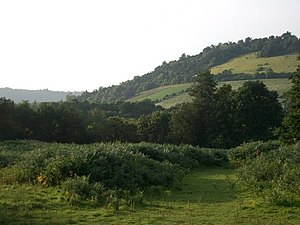 Box Hill | |||
| Range: | North Downs | ||
| Summit: | 735 feet TQ179511 51°14’49"N, 0°18’44"W | ||
Box Hill is a large and prominent hill in the North Downs, in Surrey. It reaches 735 feet above sea level at Betchworth Clumps and is a popular day out in season for the folk of Surrey. From the west, the hill presents a broad greensward way up towards its summit, often dotted with summer picnickers. Steep wooded slopes are to either side. The main escarpment of the North Downs is represented by the south slope, to which thick woodland clings.
The hill takes its name from the ancient box woodland found on the steepest west-facing chalk slopes overlooking the River Mole.
The western part of the hill is owned and managed by the National Trust, whilst the village of Box Hill lies on higher ground to the east. The most popular viewpoint is Salomon's Memorial overlooking the town of Dorking.[1]
Box Hill lies within the Surrey Hills Area of Outstanding Natural Beauty and forms part of the Mole Gap to Reigate Escarpment Site of Special Scientific Interest. The north- and south-facing slopes support an area of chalk downland, noted for its orchids and other rare plant species.[2] The hill provides a habitat for 40 species of butterfly,[2] and has given its name to a species of squash bug, now found throughout south-eastern Britain.[3]
Visitors
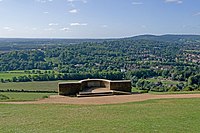
An estimated 850,000 people visit Box Hill each year.[1] The National Trust visitors' centre provides both a cafeteria and gift shop and the panoramic views of the western Weald may be enjoyed from the North Downs Way, a long distance footpath that runs along the southern escarpment.
Box Hill features prominently on the route of the 2012 Summer Olympics cycling road race events, the men doing nine circuits and the women doing two circuits.[4]
Geography
Box Hill stands at the south eastern corner of the Mole Gap, the valley carved by the River Mole through the North Downs.[5] Box Hill School is located in the village of Mickleham about a mile to the north and the hill overlooks the town of Dorking to the southwest.
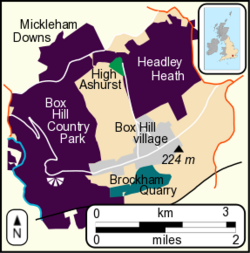
The National Trust owns and manages much of the western and northeastern part of Box Hill. Leopold Salomons, owner of Norbury Park donated 230 acres in 1914 in order to protect it from development.[5] Additional land was purchased or donated between 1921 and 1999 and today the Box Hill estate covers an area of around 1,200 acres, including Mickleham Downs to the north and Lower Boxhill Farm to the south.[5][6]
Box Hill village

The village of Box Hill is located to the east of the National Trust property. The earliest flint cottages date from the 1800s, although much of the village was constructed in the first half of the 20th century.[7] By 2005 there were more than 800 dwellings of which over five hundred were mobile homes. An estimated 41% of the community is aged 60 or over.[8] St Andrew's Church, part of the Parish of Headley, was opened in 1969 and the village hall opened in 1972.[9][10]
Environment
Box Hill is a Special Area of Conservation and included in a designated Site of Special Scientific Interest, affording it a level of legislative protection against planning applications. The chalk downland environment supports notable populations of bats, lepidopterans, orchids and the hill's namesake, the box tree (buxus sempervirens).[11]
History
Early History
The earliest archeological evidence of human activity on Box Hill are two Bronze Age round barrows located close to the Salomons Memorial. The larger barrow is 66 feet in diameter and 7 feet 3 inches high, although a slight depression in the top, suggests that it may have been partially excavated or robbed. In mediæval times the larger barrow was used as a boundary marker or mere for the parish of Mickleham.[12] Traces of prehistoric field boundaries are visible on Burford Spur and the low flint banks on the steeper and more wooded White Hill may be contemporaneous.[12]
Mediæval and Early Modern Periods
The origin of the Box trees growing on the hill is disputed: Several sources from the late eighteenth century suggest that the first Box Trees on the Hill were planted by Thomas Howard, 21st Earl of Arundel during the reign of Charles I.[13] Older mediæval documents however make reference to local individuals with surnames including Atteboxe, de la Boxe and Buxeto, suggesting that Box was already common in the local area by the 13th century,[14] and it has also been observed that Thomas Howard never owned the Box Hill estate.[15] The diarist John Evelyn records a visit to the hill in August 1655 to view "those natural bowers, cabinets and shady walks in the box copses." The close grain of the Box wood made it highly prized for its timber for carving and there are numerous accounts of the sale of trees from the hill throughout the seventeenth and eighteen centuries.[16]
The long barrows or pillow mounds to the northeast of the Salomons Memorial are thought to date from the mediæval period and were probably constructed as artificial warrens for rabbits. High Ashurst warren is recorded as remaining in use until the late 18th century.[17] A second warren was probably situated close to Warren Farm in the Headley Valley and it has been speculated that the present farmhouse was originally the warrener's cottage.[17]
20th Century
The proposals for a land value tax outlined by Chancellor David Lloyd George in his People's Budget of 1909 prompted the trustees of the Deepdene estate to start to sell the unimproved land on the western side of Box Hill.[18] As a result of negotiations led by Sir Robert Hunter, one of the founders of the National Trust, Leopold Salomons of Norbury Park purchased 230 acres which included the Old Fort, Swiss Cottage and the western flank of the hill above the River Mole, for £16,000.[19]
Two further purchases transferred Lodge Hill and Ashurst Rough to National Trust ownership in 1921 and 1923.[20] The Trust continued to purchase land, and by the mid 1980s the estate comprised some 1,200 acres.[20] The most recent additions to the Box Hill Estate include farmland at Westhumble and at the foot of the hill, purchased in the late 1990s.[20]
The National Trust also owns Headley Heath, a geologically distinct area of heathland which lies to the northeast of Box Hill village. The majority of the heath was acquired in a single purchase in 1946.[20]
Public access
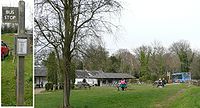
Box Hill was given to the nation by Leopold Salomons in 1914.
A country park, owned by the National Trust, now provides public access to Box Hill, and the Pilgrims' Way long distance footpath runs less than a mile to the south.
On the hill there are car parks and a viewpoint, from where the town of Dorking can be viewed. But that is not the highest point: the ridge rises toward the east, and most of the village of Box Hill is higher, at an altitude of around 650 feet. The Ordnance Survey mark a spot height of 735 feet at the radio mast at 2040&y=1 5175&z=120 TQ 2040 5175.
Near the viewpoint there is a National Trust shop containing a small visitor centre, and a café (take-away only). The car parks are owned and run by the National Trust. Details of footpaths are available in this area. There are a number of public footpaths, but they are not necessarily clearly marked (e.g. the 'Family Fun Trail', details of which are available in the shop).
Box Hill is served by local and London bus routes,[21] providing access to both the visitor centre[22] and the foot of the hill,[23] where there is another car park (opposite the Burford Bridge Hotel) that is frequented by motorcyclists.
The route to the top from the A24, known as the Zig Zag Road, is quite steep and is a popular test of fitness for cyclists. There is another small car park halfway up this road, with room for only around 10 cars. The Zig-zag is part of the 2012 Olympic cycling course.
Notable Sights
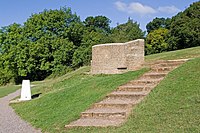

Salomons Memorial
The most notable sight on Box Hill is the view from the viewing platform. There can be a very clear view, roughly south over Dorking and further towards Gatwick Airport and right across to the South Downs, including Chanctonbury Ring and Devil's Dyke, Sussex (a distance of 26 miles, according to the inscription on the viewing platform).
The Salomons Memorial is sometimes mistakenly thought to be at the summit of the hill, but the land continues to rise to the east. The highest point is at Betchworth Clumps, a wooded area to the south of the Hand-in-Hand public house, at an elevation of 735 feet. The summit is occupied by a water tower and transmitter mast.
The Old Fort
The Old Fort is one of 13 mobilisation centres (known collectively as the London Defence Positions) built in the 1890s to protect London from invasion from continental Europe.[24] The six acre site of the fort was originally purchased by the Ministry of Defence in 1891, and construction began in 1896.[25] Box Hill fort was laid out in the form of an infantry redoubt, typical of the period, but also included magazines for the storage of artillery ammunition.[25] (In common with the majority of the twelve other mobilisation centres, the Box Hill fort was designed for the use of the infantry only and the stored ammunition was intended for the use of mobile field artillery which would be deployed nearby as required.[25]) A reform of defence policy by the Secretary of War Viscount Haldane in 1905 resulted in all 13 centres being declared redundant, and Box Hill Fort was sold back to the estate trustees in 1908.[26]
The building cannot be entered by visitors. It is inhabited by bats, which are protected species.[26]
Broadwood's Folly
The circular flint tower located on the northern tip of Lodge Hill was built for the piano maker Thomas Broadwood, who purchased Juniper Hall in 1815.[27][28]
Zig Zag Road

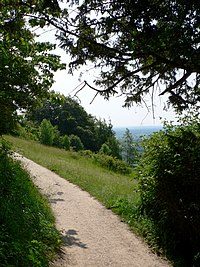
The Zig Zag Road is the most direct route to the National Trust visitors' centre from the Mole Gap for both cars and bicycles. The exact age of the Zig Zag Road is uncertain, but it first appears on the Ordnance Survey map of 1869,[29] and has been popular with cyclists since the 1880s.[30]
The road is a steady climb of 390 feet over 1.6 miles and, although on a much smaller scale, has been likened to the Alpe d'Huez in the French Alps.[31] Box Hill will feature prominently on the route of the 2012 Summer Olympics cycling road race events: the men will climb the Zig Zag Road nine times and the women twice.[4]
Labilliere's Grave
Peter Labilliere was born in Dublin on 30th May 1725 to a family of French Huguenot descent. He joined the British Army at the age of 14, becoming a major in 1760.[32] After leaving the army he became a political agitator and was accused in 1775 of bribing British troops not to fight in the American War of Independence, although he was never tried for treason.[33] Throughout the 1770s and 80s Labiliere corresponded regularly with both Benjamin Franklin (at that time the American representative in France) and the Long Island wax sculptor Patience Wright.[34] The effect of his anti-war protests on British public sentiment is uncertain, although he appears to have attracted a following of over 700 like-minded adherents,[35] and the army was required to rely on German mercenaries, as recruitment of British troops for the war became increasingly difficult.[36]
Labilliere moved to Dorking from London in around 1789,[33] and often visited Box Hill to meditate.[37] With old age he became increasingly eccentric and neglected his own personal hygiene to such an extent that he acquired the nickname "the walking dung-hill".[37] In accordance with his wishes he was buried head downwards in June 1800 on the western side of Box Hill above The Whites. He was buried without any religious ceremony and Labilliere is reported to have said that the world was "topsy-turvey" and that it would be righted in the end. But there was no mention of this in his "Book of Devotions": rather this states that he wished to emulate the example of St Peter, who was crucified upside-down according to mediaeval tradition.[38] This book was taken by the youngest daughter of his landlady who passed it down to her children. It is now in Dorking Museum along with some of his personal trinkets.
The memorial stone on Box Hill is not believed to mark the exact location of his burial (which is thought to be several yards to the west on a steep incline). There are two errors on the memorial stone itself: He was buried in June 1800 (rather than July) and all surviving manuscripts indicate that he spelt his name Labilliere (rather than Labelliere).[39][40]
Weypole and Stepping Stones
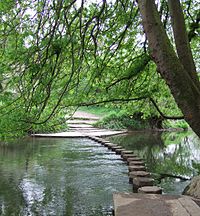


The Weypole (or Waypole) is a roughly semi-circular area of level ground at the foot of Box Hill, between The Whites and the River Mole.[41] The area was originally part of the grounds of Burford Lodge, built by John Eckersall in 1776, and the apple and cherry trees in the area suggest that it was used as an orchard for a time.[42] The Burford Lodge estate was later owned by the horticulturalist Sir Trevor Lawrence]], who created a garden along the banks of the Mole for his collection of orchids.[43]
A ford across the River Mole is thought to have existed here since prehistoric times.[44] The way-pole was a notched post secured in the riverbed, to indicate the depth of the water.[45] Stepping stones at this site are first recorded in 1841 and they may have been installed by an owner of Burford Lodge to facilitate access to the Weypole orchard.[46] The current stones were dedicated in September 1946 by the then Prime Minister Clement Attlee, replacing those destroyed during World War 2 as an anti-invasion measure.[47][48] The spot is popular with both anglers and families, although swimming is strongly discouraged. The stones give their name to the pub in the nearby village of Westhumble.
Other
John Logie Baird, the inventor of the first working television system, lived at Swiss Cottage from 1929 until 1932.[49] Baird conducted some of his experiments on Box Hill,[50] including his Noctovisor,[51] an infra-red viewing device.
Cultural references
John Evelyn notes in his Diary in 1662 that Box Hill was frequented by the ladies and gentlemen from nearby Epsom spa.[52]
In 1733, George Lambert painted Box Hill. The painting is now in The Tate.[53]
An important passage of Jane Austen's novel Emma is set at Box Hill.
In England: A Nation, (London: R. Brimley Johnson, 1904), edited by Lucian Oldershaw, and in a chapter entitled "The Patriotic Idea" written by G. K. Chesterton, the beauty of Box Hill violated by an invading army is used to express a healthy patriot's love for his nation is opposed to the jingoistic nationalism of tabloid newspapers: "But just as a man who has been in love will find it difficult to write a whole frantic epic about a flirtation, so all that kind of rhetoric about the Union Jack and the Anglo-Saxon blood, which has made amusing the journalism of this country for the last six years, will be merely impossible to the man who has for one moment called up before himself what would be the real sensation of hearing that a foreign army was encamped on Box Hill."
The 1981 Public Image Ltd song “The Flowers of Romance”, from the album of the same title, includes the line “I’ve got binoculars on top of Box Hill”.
British biker rock band, Dumpy's Rusty Nuts, released a single called 'Boxhill or Bust' in the early 1980s. The song is something of a cult anthem for bikers, and reflects the popularity of Box Hill amongst the biking community.
Musician Ben Watt of Everything But The Girl wrote a song "On Box Hill", released as the B side of the single "Some Things Don't Matter" (Cherry Red Records) in 1983. This song about a sunny day on Box Hill also appears on his début album North Marine Drive.
In Richard Thompson's song "1952 Vincent Black Lightning", Box Hill is the location to which James and Red Molly ride on James' motorcycle. In the cover version of this song by bluegrass artist Del McCoury on the album Del and the Boys, Box Hill is changed to Knoxville, a city in Tennessee, U.S.A.
Mystery author Cyril Hare sets his 1954 novel, That Yew Tree's Shade (published in the U.S. as Death Walks the Woods) at "Yew Hill," which Hare admits in an introduction is modelled on Box Hill.
Actor and singer Tom Felton's song called "Time Well Spent" mentions him going to "chill out on Box Hill".
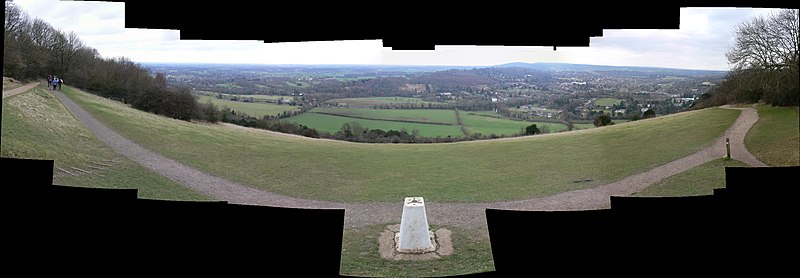
References
- ↑ 1.0 1.1 "Box Hill Visitor Facilities and Car Park: Planning Application for Proposed Improvements". Mole Valley District Council. http://www.mole-valley.gov.uk/cwi/getDocument?docId=188328&account=planning&ref=MO/2009/0647&filename=Design%20Statement. Retrieved 3 April 2011.
- ↑ 2.0 2.1 Oates M (2008). "Box Hill". Places to Visit for Wildlife. National Trust. http://www.nationaltrust.org.uk/main/w-vh/w-visits/w-great_days_out/w-nature-places_to_visit/w-nature-places_to_visit-boxhill.htm. Retrieved 3 April 2011.
- ↑ Bantock T and Botting J (2010). "Gonocerus acuteangulatus Box Bug". British Bugs: An online identification guide to UK Hemiptera. www.britishbugs.org.uk. http://www.britishbugs.org.uk/heteroptera/Coreidae/gonocerus_acuteangulatus.html. Retrieved 29 March 2011.
- ↑ 4.0 4.1 "Olympics 2012: cycling road race route" (Adobe Flash). Guardian. 2011-02-11. http://www.guardian.co.uk/sport/interactive/2011/feb/10/olympics-2012-cycling-road-race-route. Retrieved 2011-02-18.
- ↑ 5.0 5.1 5.2 Bannister 1999, p. 2
- ↑ Welcome To Box Hill, National Trust pamphlet, 2008
- ↑ Mountford 1974, pp. 3–4
- ↑ Fry R (2006). "Box Hill Project". Community Case Studies. The Connected Surrey Partnership. http://www.connectedsurrey.com/stylesheet.asp?file=17032006112104. Retrieved 13 April 2011.
- ↑ Langley D (2000). "History". The Church on the Hill. Friends of St Andrews Box Hill. http://myweb.tiscali.co.uk/friendsofstandrewsbh/history_part_1.htm. Retrieved 3 April 2011.
- ↑ Mountford 1974, p. 3
- ↑ Box Hill Community Website accessed 4th February 2008
- ↑ 12.0 12.1 Bannister 1999, p. 12
- ↑ Beavan 1777, p. 2
- ↑ Brayley & Britton 1841, p. 461
- ↑ Littledale & Locock 1984, p. 12
- ↑ Littledale & Locock 1984, p. 13
- ↑ 17.0 17.1 Bannister 1999, p. 20
- ↑ Littledale & Locock 1984, p. 15
- ↑ Littledale & Locock 1984, pp. 15–16
- ↑ 20.0 20.1 20.2 20.3 "National Trust Acquisition Data". National Trust. 2010. http://www.nationaltrust.org.uk/servlet/file/store5/item724521/version1/nt_acquisitions_dec2011-2.pdf. Retrieved 12 February 2012.
- ↑ Getting there from The National Trust website. Accessed 12 February 2008
- ↑ "Surrey County Council — 516 bus timetable via Box Hill visitor centre". http://www.surreycc.gov.uk/sccwebsite/sccwspublications.nsf/WebLookupFileResourcesByUNID/docidF9D4ED4E860D1F9F8025729600568D66?openDocument. Retrieved 2012-07-27.
- ↑ "Surrey County Council — 465 bus timetable via foot of Box Hill". http://www.surreycc.gov.uk/sccwebsite/sccwspublications.nsf/WebLookupFileResourcesByUNID/docid2D0E4B78B92134EC802572960054AE40?openDocument. Retrieved 2012-07-27.
- ↑ "Box Hill Fort". Historic Forts on Waymarking.com. waymarking.com. 2006. http://www.waymarking.com/waymarks/WMGCY. Retrieved 10 February 2012.
- ↑ 25.0 25.1 25.2 Littledale & Locock 1984, p. 23
- ↑ 26.0 26.1 Bannister 1999, p. 27
- ↑ Wainwright 1982, p. 338
- ↑ Goodge M (2005). "The Broadwood Folly at Juniper Hall, Dorking". British Listed Buildings. http://www.britishlistedbuildings.co.uk/en-494323-the-broadwood-folly-at-juniper-hall-dork. Retrieved 28 April 2011.
- ↑ Bannister 1999, p. 24
- ↑ London bicycle club gazette 6: 147. 1883.
- ↑ Warren 2010, p. 37
- ↑ Lander 2000, pp. 7–8
- ↑ 33.0 33.1 Lander 2000, pp. 20–21
- ↑ Lander 2000, p. 24,30
- ↑ Lander 2000, p. 25
- ↑ Lander 2000, p. 19
- ↑ 37.0 37.1 Lander 2000, pp. 35–36
- ↑ Lander 2000, pp. 39–40
- ↑ Lander 2000, p. 6
- ↑ No, Doilum. "Box Hill, Surrey sur Flickr : partage de photos !". Flickr.com. http://flickr.com/photos/doilum/387839851/. Retrieved 2012-07-27.
- ↑ "National Trust Acquisition Data". National Trust. 2010. http://www.nationaltrust.org.uk/servlet/file/store5/item724521/version1/nt_acquisitions_dec2011-2.pdf. Retrieved 12 February 2012.
- ↑ Chapman & Young 1979, p. 164
- ↑ Chadwick & Chadwick 2006, p. 121
- ↑ Ashton & Blight 2006, p. 65
- ↑ A Son of the Marshed (1890). "A Surrey River". The Living Age (Littell) 185 (2395): 486–497.
- ↑ Brayley & Britton 1841, p. 179
- ↑ "Box Hill, Surrey: walk of the week". Daily Telegraph. 2 March 2011. http://www.telegraph.co.uk/travel/activityandadventure/walkingholidays/8356605/Box-Hill-Surrey-walk-of-the-week.html. Retrieved 29 March 2011.
- ↑ "Picture of the Week". Life (Time Inc.) 21 (13): 36. 1946.
- ↑ Burns 2000, p. 205
- ↑ "South East | Box Hill & Headley Heath". National Trust. 2011-11-17. http://www.nationaltrust.org.uk/main/w-global/w-localtoyou/w-south_east/w-south_east-countryside/w-south_east-places-north_downs/w-south_east-places-north_downs-box_hill_headley_heath.htm. Retrieved 2012-07-27.
- ↑ "Baird". Web.archive.org. 2009-10-27. http://web.archive.org/web/20091027123028/http://geocities.com/neveyaakov/electro_science/baird.html. Retrieved 2012-07-27.
- ↑ Noted in Alice M. Coats, Garden Shrubs and Their Histories (1964) 1992, s.v. "Buxus".
- ↑ "A view of Box Hill, Surrey" at Tate|The Tate
Bibliography
- Ashton, S; Blight, G (2006). The south east of England: Exploring Woodland. London: Frances Lincoln. ISBN 978-0-7112-2659-3.
- Bannister, NR (1999). The Box Hill Book of Archaeology. Dorking, Surrey: Friends of Box Hill. ISBN 0-9534430-1-9.
- Beavan, E (1777). Box Hill, a descriptive poem. London: Wilkie.
- Belloc, H (1911). The Old Road. London: Constable and Company.
- Brayley, E. W.; Britton, J. (1841). A topographical history of Surrey. Surrey: Dorking.
- Burns, RW (2000). John Logie Baird: Television pioneer. History of Technology. 28. London: Institution of Electrical Engineers.
- Chadwick, AA; Chadwick, AE (2006). The Classic Cattleyas. Portland, Oregon: Timber Press. ISBN 978-0-88192-764-1.
- Chapman, GM; Young, RHD (1979). Box Hill. Lyme Regis: Serendip. ISBN 0-9504143-1-X.
- Headley, G; Meulenkamp, W (1986). Follies: A National Trust Guide. London: Jonathan Cape. ISBN 0-224-02105-2.
- Lander, J (2000). Peter Labilliere: The Man Buried Upside Down on Box Hill. Chertsey: Post Press. ISBN 978-0-9532424-1-2.
- Littledale, H; Locock, LM; Sankey JHP (1984). Box Hill. Dorking, Surrey: Box Hill Management Committee.
- Mountford, F (1974). The Box Hill Guide. Tadworth: Mountford. ISBN 0-9503540-0-7.
- Sankey, A (2000). The Box Hill Book of Orchids. Dorking, Surrey: Friends of Box Hill. ISBN 0-9534430-2-7.
- Wainwright, D (1982). Broadwood by Appointment: A History. London: Quiller Press. ISBN 0-907621-10-4.
- Warren, S (2010). 100 Greatest Cycling Climbs: A road cyclist's guide to Britain's hills. London: Frances Lincoln. ISBN 978-0-7112-3120-7.
- Wooldridge, SW; Hutchings, GE (1957). London's Countryside : Geographical Field Work for Students and Teachers of Geography. London: Methuen.
Outside links
| ("Wikimedia Commons" has material about Hill Box Hill) |
